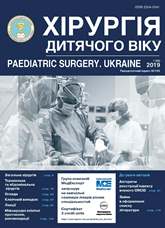Early diagnosis of bacterial contamination of the abdominal cavity with destructive appendicitis in children using the test system «D-lactam»
DOI:
https://doi.org/10.15574/PS.2019.62.25Keywords:
acute destructive appendicitis, peritonitis, D-lactate, pediatric surgery, microorganismAbstract
Objective. To determine the diagnostic value of the test system «D-lactam» for the diagnosis of bacterial contamination of the abdominal cavity in acute destructive appendicitis (ODA) and its purulent complications in children.
Materials and methods. The main group of patients included 48 children with ODA, control – 12, routinely hospitalized in the pediatric surgical department of Vitebsk Regional Clinical Center for Children. In the main group, 34 (70.83%) patients underwent an uncomplicated ODA (subgroup I), and 14 (29.17%) children had ODA complicated by peritonitis (subgroup II). The median of hospital stay was 11 (10-12) bed-days (subgroup I) and 17.5 (14-19) bed-days (subgroup II). The peritoneal exudate (PE) was collected during emergency and planned open and laparoscopic operations for ODA (n=48), inguinal hernia (n=8), varicocele (n=3), abdominal cryptorchidism (n=1). The material was sent for bacteriological analysis and D-lactate. Bacteriological analysis of PE was performed on a Vitek 2 CompactBiomerieux microbiological analyzer (France). Statistical analysis was carried out in the program Statistica 10.0, SPSS 19 and MedCalc 10.2.
Results. The level of D-lactate in PE in 48 patients of the main group was 1.21 (0.58–2.85) mmol/l (min 0.19 mmol/l – max 4.89 mmol/l). The median of D-lactate concentration of PE in the control group was 0.26 (0.2–0.31) mmol/l (min 0.16 mmol/l – max 0.34 mmol/l), which is statistically significant (U-test Mann–Whitney, p<0.0001) exceeds that in patients with ODA. During the ROC analysis, it was found that the level of D-lactate in PE exceeding 0.335 mmol/l indicates that the patient has bacterial contamination with a sensitivity of 89.6% (95% CI: 77.3…96.5) and specificity 100% (95% CI: 73.5…100), the field area under the curve AUC=0.938 (95% CI: 0.872 … 0.996) (p<0.001), which makes it possible to consider determining the level of D-lactate in PE as a good method of express diagnosis of bacterial infections of the abdominal cavity.
Conclusions. The use of the «D-Lactam» test system with the determination of D-lactate in PE exceeding 0.335 mmol/l reliably (p<0.001) indicates the presence of bacterial contamination of the abdominal cavity in patients with ODA.
References
Zenkova SK. (2009). Bakterialnyie meningityi: kliniko-epidemiologicheskie i patogeneticheskie osobennosti, lechenie. Vitebsk: 157.
Isakov YuF, Stepanov EA, Dronov AF. (1980). Ostryiy appenditsit v detskom vozraste. Moskva: Meditsina: 192.
Karaseva OV, Roshal LM, Bryantsev AV, Kapustin VA, Chernyisheva TA, Ivanova TF. (2007). Lechenie appendikulyarnogo peritonita u detey. Detskaya hirurgiya. 3: 23–27.
Savelev VS (red.), Gelfand BR (red.) (2006). Abdominalnaya hirurgicheskaya infektsiya: klinika, diagnostika, antimikrobnaya terapiya: prakticheskoe rukovodstvo. Moskva: Literra: 168.
Semenov VM, Zenkova SK, Dmitrachenko TI, Veremey IS, Kubrakov KM, Skvortsova VV, Vasileva MA. (2014). Bakterialnyie patogenyi kak produtsentyi D-laktata. Zhurnal infektologii. 6;2:90.
Chen Z et al. (2012). The clinical diagnostic significance of cerebrospinal fluid D-lactate for bacterial meningitis. Clin Chim Acta. 413:1512–1515. https://doi.org/10.1016/j.cca.2012.06.018; PMid:22713513
Manutin PV, Uchvatkin VG, Rybin EP et al. (1997). General and local antibiotic treatment with ceftriaxone of suppurativc-septic diseases and complications! Anestcatol. Rcammatol. 3:14–18.
Muehlstedt SG, Pham TQ, David J Scheling. (2004). The management of pediatric appendicitis: a survey of North American Pediatric Surgeons. J Pediatr Surg. 39;6:875–879. https://doi.org/10.1016/j.jpedsurg.2004.02.035; PMid:15185217
Schem M, AssalLa A., Bachus H. (1994). Minimal antibiotic therapyr after emergency abdominal surgery: a prospective study. BJS. 81;7: 989–991. https://doi.org/10.1002/bjs.1800810720; PMid:7922094
Tavarez WM et al. (2006). CSF markers for diagnosis of bacterial meningitis in neurosurgical postoperative patients. Arq. Neuropsiquiatr.64:592–595. https://doi.org/10.1590/S0004-282X2006000400012; PMid:17119799
Warner BW, Kulick RM, Stoops MM. (1998). An evidence-based clinical pathway for acute appendicitis decreases hospital duration and cost. J Pediatr Surg. 33;9: 1371–1375. https://doi.org/10.1016/S0022-3468(98)90010-0
Downloads
Issue
Section
License
The policy of the Journal “PAEDIATRIC SURGERY. UKRAINE” is compatible with the vast majority of funders' of open access and self-archiving policies. The journal provides immediate open access route being convinced that everyone – not only scientists - can benefit from research results, and publishes articles exclusively under open access distribution, with a Creative Commons Attribution-Noncommercial 4.0 international license(СС BY-NC).
Authors transfer the copyright to the Journal “PAEDIATRIC SURGERY.UKRAINE” when the manuscript is accepted for publication. Authors declare that this manuscript has not been published nor is under simultaneous consideration for publication elsewhere. After publication, the articles become freely available on-line to the public.
Readers have the right to use, distribute, and reproduce articles in any medium, provided the articles and the journal are properly cited.
The use of published materials for commercial purposes is strongly prohibited.

